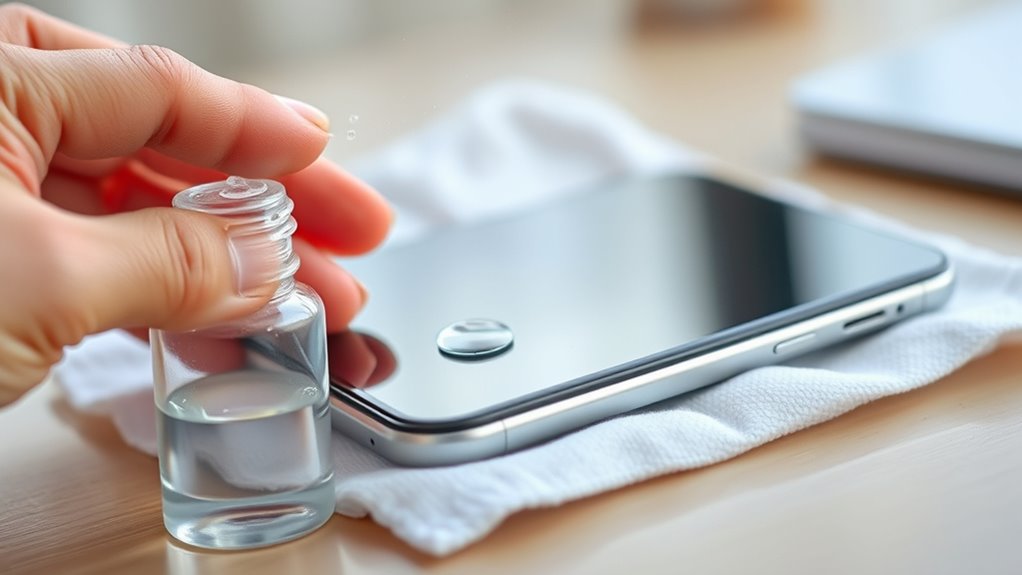To sanitize your cell phone and electronics safely, start by removing dirt with a soft, lint-free cloth. Lightly dampen it with water or 70% isopropyl alcohol and wipe surfaces gently. For a chemical-free option, use a UV light sanitizer designed for electronics, following the device instructions closely. Avoid excess moisture and harsh chemicals, and always prep your device beforehand. If you want to learn more about effective methods, keep exploring these tips.
Key Takeaways
- Remove dirt with a soft, lint-free cloth before sanitizing to prevent scratching and ensure effective cleaning.
- Use disinfectant wipes safe for electronics, such as those with 70% isopropyl alcohol, to disinfect screens and surfaces.
- Employ UV light sanitizers designed for electronics, following manufacturer instructions for safe and effective UV exposure.
- Avoid excessive moisture; lightly dampen cloths or wipes to prevent liquid damage to devices.
- Combine cleaning methods—like wiping and UV sanitizing—for comprehensive disinfection without risking device harm.

In today’s digital age, our cell phones and electronics are constantly exposed to dirt, germs, and bacteria from everyday use. Every time you touch your device, you transfer oils, sweat, and potentially harmful microbes onto its surface. Properly sanitizing your electronics is essential for maintaining your health, but you want to do it without causing damage. One effective method gaining popularity is UV light sanitization, which uses ultraviolet light to kill germs without the need for harsh chemicals. This technology offers a quick, chemical-free way to disinfect your devices safely. When it comes to electronic device cleaning, UV sanitizers are designed specifically for gadgets, ensuring the process is both thorough and gentle. Using UV light devices, you simply place your phone or other electronics inside, turn it on, and let the UV rays do their work. It’s convenient, fast, and safe for most screens and surfaces, making it ideal for regular use.
Before using any sanitizing method, it’s important to remove visible dirt and debris. Wipe your device with a soft, lint-free cloth to eliminate dust and smudges. If needed, lightly dampen the cloth with water or a 70% isopropyl alcohol solution, but avoid excess moisture that could seep into your device. Once the surface is clean, you can proceed with UV light sanitization if you have a compatible device. These UV sanitizers are designed to prevent damage to your electronics while effectively killing bacteria and viruses. Always follow the manufacturer’s instructions to ensure proper use and avoid overexposure, which could potentially harm some screens or coatings. For devices that can’t be exposed to UV light, or if you prefer additional cleaning, use disinfectant wipes specifically made for electronics. These wipes are formulated to be safe on screens and sensitive surfaces, providing an extra layer of protection against germs.
Frequently Asked Questions
Can I Use Alcohol-Based Wipes on All Electronics Safely?
You wonder if alcohol-based wipes are safe for all electronics. While alcohol is compatible with many devices, it can damage certain screen coatings or plastics. Before using, check your device’s manufacturer guidelines to confirm alcohol compatibility and screen coating safety. If unsure, opt for gentle, non-abrasive disinfectants. Always apply wipes lightly and avoid excess moisture to prevent damage, ensuring your electronics stay clean without harm.
How Often Should I Sanitize My Devices?
Did you know your phone can harbor 10 times more bacteria than a toilet seat? You should sanitize your devices weekly to reduce contamination risks and protect their device lifespan. Regular cleaning prevents bacteria buildup and keeps your electronics functioning smoothly. By making it a routine, you lower health risks and extend your device’s longevity. So, stay proactive and clean your gadgets at least once a week for superior safety and performance.
Are There Eco-Friendly Sanitizing Options for Electronics?
You’ll find eco-friendly cleaning options for your electronics by choosing plant-based disinfectants. These products are gentle on your devices and better for the environment. Look for brands that emphasize natural ingredients and avoid harsh chemicals. Using these plant-based disinfectants, you can effectively sanitize your electronics while reducing your ecological footprint. Eco-friendly cleaning not only keeps your devices safe but also supports sustainability efforts for a healthier planet.
Will Cleaning Damage My Device’S Screen or Coating?
Think of your device’s screen coatings like a delicate fresco—vulnerable to harsh cleaning chemicals. If you use aggressive cleaners, you could damage those coatings, causing discoloration or scratches. Instead, opt for gentle, non-abrasive wipes and mild solutions. Your goal is to clean without stripping away the protective layers, so always check product labels and avoid anything too abrasive. This way, your screen stays pristine and protected over time.
Is It Safe to Sanitize My Electronics During Travel?
Yes, sanitizing your electronics during travel is safe if you’re careful. Remove screen protectors to avoid damage and clean them separately. Use alcohol-based wipes or sprays that are safe for electronics, avoiding excess liquid near charging ports. Be gentle around sensitive areas, and avoid excessive moisture. Regular sanitizing helps prevent germs, but always follow manufacturer guidelines to keep your device safe and make sure it functions properly during your trip.
Conclusion
Now that you know how to safely sanitize your electronics, you can keep them as clean as a whistle without risking damage. Think of it like giving your devices a gentle spa day—refreshing and revitalizing without the harshness. Regular cleaning not only keeps germs at bay but also prolongs their lifespan. So, grab your supplies and make sanitizing part of your routine—your devices will thank you, and so will your health.










